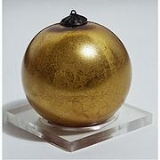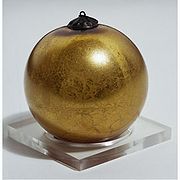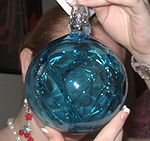
Witch ball
Encyclopedia

England
England is a country that is part of the United Kingdom. It shares land borders with Scotland to the north and Wales to the west; the Irish Sea is to the north west, the Celtic Sea to the south west, with the North Sea to the east and the English Channel to the south separating it from continental...
to ward off evil spirits, witch's spells or ill fortune, though the Witch's Ball actually originated among cultures where witches were considered a blessing and these witches would usually "enchant" the balls to enhance their potency against evils. Later, they were often posted on top of a vase or suspended by a cord (as from the mantelpiece or rafters) for a decorative effect. Witch balls appeared in America
United States
The United States of America is a federal constitutional republic comprising fifty states and a federal district...
in the 19th century and are often found in gardens under the name "gazing ball". However, "gazing balls" contain no strands within their interior.
According to folk tales, witch balls would entice evil spirits with their bright colours; the strands inside the ball would then capture the spirit and prevent it from escaping.
Witch balls sometimes measure as large as 7 inches (18 cm) in diameter. The witch ball is traditionally, but not always, green or blue in color and made from glass (others, however, are made of wood, grass, or twigs instead of glass). Some are decorated in enameled swirls and brilliant stripes of various colors. The gazing balls found in many of today's gardens are derived from the silvered witch balls that acted as convex mirrors, warding off evil by reflecting it away.

Glass float
Glass floats, glass fishing floats, or Japanese glass fishing floats are popular collectors’ items. They were once used by fishermen in many parts of the world to keep their fishing nets, as well as longlines or droplines afloat....
used on fishing nets, witch balls are often associated with sea superstitions and legends. In the Ozark Mountains, a witch ball is made from black hair that is rolled with beeswax
Beeswax
Beeswax is a natural wax produced in the bee hive of honey bees of the genus Apis. It is mainly esters of fatty acids and various long chain alcohols...
into a hard round pellet about the size of a marble and is used in curse
Curse
A curse is any expressed wish that some form of adversity or misfortune will befall or attach to some other entity—one or more persons, a place, or an object...
s. In Ozark folklore
Folklore
Folklore consists of legends, music, oral history, proverbs, jokes, popular beliefs, fairy tales and customs that are the traditions of a culture, subculture, or group. It is also the set of practices through which those expressive genres are shared. The study of folklore is sometimes called...
, a witch that wants to kill someone will take this hair ball and throw it at the intended victim; it is said that when someone in the Ozarks is killed by a witch's curse, this witch ball is found near the body.
The word witch ball may be a corruption of watch ball because it was used as a guard of evil spirits.
It is sometimes claimed that the modern Christmas ornament ball
Christmas ornament
Christmas ornaments are decorations that are used to festoon a Christmas tree.Ornaments take many different forms, from a simple round ball to highly artistic designs...
is descended from the witch ball. The ornament was allegedly originally placed on the tree to dispel a visitor’s envy at the presents left beneath the tree. However as the modern Christmas bauble's origins are documented in Lauscha
Lauscha
Lauscha is a town in the district of Sonneberg, in Thuringia, Germany. It is situated 13 km north of Sonneberg, and 24 km southwest of Saalfeld. It became known for its glassblowing.-Geography:...
, Germany
Germany
Germany , officially the Federal Republic of Germany , is a federal parliamentary republic in Europe. The country consists of 16 states while the capital and largest city is Berlin. Germany covers an area of 357,021 km2 and has a largely temperate seasonal climate...
in 1847, the provenance of this claim is debatable.

